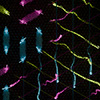| Jul 10, 2025 |
Researchers show that twisting stacked atomic layers can unlock new quantum properties, offering a fresh strategy to engineer advanced quantum materials.
(Nanowerk News) A global collaboration led in part by physicists affiliated with Donostia International Physics Center (DIPC) introduces a new framework for engineering exotic quantum matter via stacking and twisting. Their findings, published in Nature (“Moiré materials based on M-point twisting”), unveil a previously unstudied class of moiré materials.
|
|
The familiar optical interference patterns known as moiré—sometimes seen when photographing tightly spaced stripes—have an analog at the atomic scale: when two crystal lattices are twisted, new electronic patterns emerge, fundamentally transforming the landscape of quantum properties.
|
|
Moiré materials, created by slightly rotating two atomically thin layers atop one another, have become a cornerstone of modern condensed matter physics. This is because the simple geometric manipulation endows these twisted moiré systems with quantum properties not found in the original monolayers.
|
 |
| Simulations show that in some M-point moiré materials, electrons lock into crisscrossing patterns — a sign of one-dimensional behavior. In certain cases, they can also freeze into some kind of bond dimers, revealing a deeper layer of quantum order. (Image: Dumitru Calugaru)
|
|
The physical arrangement of atoms in a crystalline material is described in real space, by their coordinates. Each crystal is also characterized by a so-called reciprocal lattice in momentum space, that describes the possible values of momentum for particles within that crystal.
|
|
The key is that in the momentum space of a crystal there are some special points, such as the K-point and M-point, that characterize how electrons move and interact within materials. Each such point has unique properties that can affect how a material behaves electrically or optically.
|
|
Until now, experimental studies have focused almost exclusively on twisting hexagonal materials like graphene, and transition metal dichalcogenides, around the K-points in momentum space. But this approach limits the quantum behaviours that can be explored. In contrast, the M-point represents a fundamentally different region of momentum space, with distinct symmetry and electronic properties. Twisting around the M-point opens the door to entirely new quantum phases that are inaccessible at the K-point.
|
|
“By turning our attention to the M-points, we expand the catalog of possible quantum phases dramatically,” says Dumitru Călugăru, a Leverhulme-Peierls Fellow at the University of Oxford and longtime visitor at DIPC. “We identified materials whose band-minima, that is, electronic lowest energy levels, lie at these M-points, which opens up an entirely new frontier for designing flat-band quantum systems.” These systems are studied for their potential in engineering exotic phases of matter such as high temperature superconductivity or spin liquids.
|
|
The research team, which includes theoretical and computational physicists, chemists, and materials scientists, brings together institutions from the US, Spain, Germany, Canada, and the UK. B. Andrei Bernevig, Professor of Physics at Princeton University and Ikerbasque Visiting Professor at DIPC, helped lead the effort.
|
|
The team began by systematically identifying monolayer materials where the electrons’ lowest-energy states are located at the M-point. This led to the selection of two promising compounds, SnSe₂ and ZrS₂, and used computer simulations to theoretically “twist” these materials. What they found was striking: the twist created exceptionally flat electronic bands, a crucial feature for strong electron correlations and for unlocking exotic quantum behaviours.
|
|
“These M-point systems behave very differently from what we see at the K-point,” said Haoyu Hu, a researcher at Princeton and a former postdoc at DIPC. “Even though their electronic band structure seems simple, they exhibit a novel type of symmetry that can even lead to quasi-one-dimensionality, enabling new kinds of quantum phenomena”.
|
|
Researchers Yi Jiang and Hanqi Pi at DIPC performed large scale simulations over months showing that a tiny twist—just about three degrees—give rise to the flatness of the bands, dramatically enhancing the electron interactions, and fostering unconventional correlated states. “Twisting can localize electrons in either a hexagonal lattice or a kagome lattice arrangement,” Jiang said. Pi added, “Such localization means we can now experimentally realize diverse quantum states, potentially including quantum spin liquids.”
|
|
Theoretical advances are already being matched by experimental progress. Several of the predicted materials have been synthesized in bulk form, and they are now being exfoliated into atomically thin sheets, bringing the possibility of building the proposed M-twist structures within reach.
|
|
“The experimental realization of these materials is critical. Once twisted, gated, and measured, these new quantum states may become tangible realities,” said B. Andrei Bernevig. “Every new twist we perform seems to yield surprises. Fundamentally, these materials offer a gateway to quantum states of matter nobody has envisioned. And because they are so controllable experimentally, the possibilities truly are limitless,” he emphasized.
|
|
This work sets the stage for future experimental breakthroughs—and could mark a turning point in how scientists design and explore next-generation quantum materials.
|


